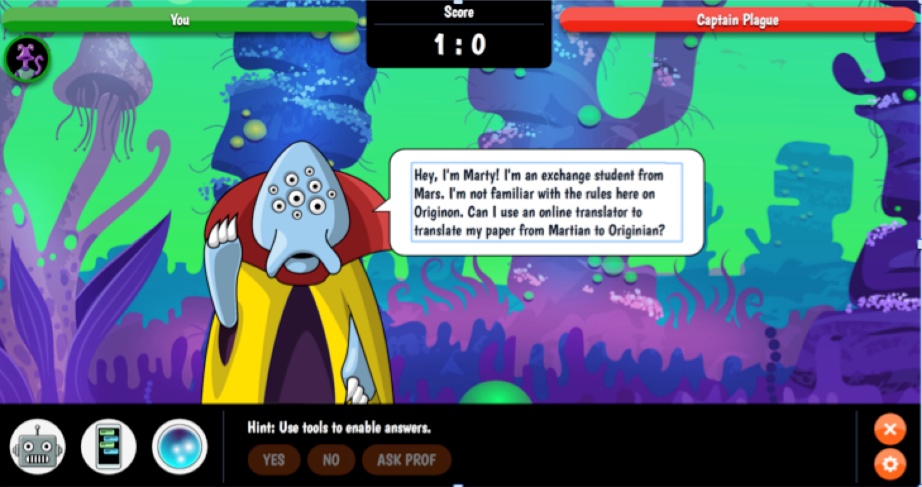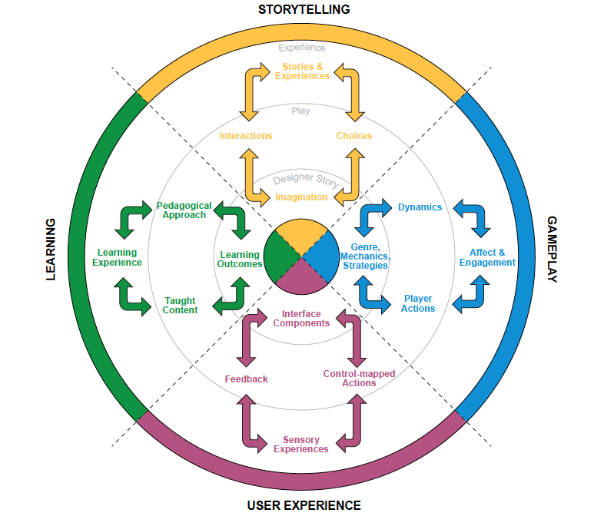2. Emerging Technologies: Serious Games and Gamification
2.2. Serious Games
Gartner’s hype cycle is best considered as a way of thinking about emerging technologies, rather than as a factual representation of their development. For instance, serious games are more of a slow burner. There have never been vastly inflated expectations about their likely impact on education; indeed, for a long time, they have been written off as too expensive or not appropriate for serious education. However, that view has been changing in recent years.
What are Serious Games?
There are several different definitions of serious games. I have included two definitions that cover both educational and corporate settings.
The Financial Times Lexicon offers the following definition:
Serious games are games designed for a purpose beyond pure entertainment. They use the motivation levers of game design – such as competition, curiosity, collaboration, individual challenge – and game media, including board games through physical representation or video games, through avatars and 3D immersion, to enhance the motivation of participants to engage in complex or boring tasks. Serious games are therefore used in a variety of professional situations such as education, training, assessment, recruitment, knowledge management, innovation and scientific research.
Zhonggen (2019) provides this definition in his comprehensive review of the research on serious games:
Serious games are referred to as entertaining tools with a purpose of education, where players cultivate their knowledge and practice their skills through overcoming numerous hindrances during gaming.
It is important to distinguish between serious games, game-based learning and gamification because of the differences in their purpose, approach and impact on learning.
- Game-based learning refers to “the pedagogical approach of utilizing games in education” (Anastasiadis, Lampropoulos and Siakas, 2018)
- Gamification is defined as the “use of game design elements in non-game contexts” (Deterding et al., 2011)
Note that serious games are not necessarily digital. However, whether digital or not, they are governed by similar principles of design, such as mechanics, dynamics and aesthetics (Hunicke et al., 2004).
Why User Serious Games?
The main reasons offered for using games in education are to:
- Improve students’ motivation to learn
- Engage learners more deeply in the learning process
- Improve learning outcomes
- Improve attendance and participation
However, an extensive review of the literature conducted by Dichev and Dicheva in 2017 found that research remains inconclusive on these assumptions. They also found that:
- The practice of gamifying learning has outpaced researchers’ understanding of its mechanisms and methods;
- Insufficient high-quality evidence exists to support the long-term benefits of serious games in an educational context;
- A limited understanding that how to gamify an activity depends on the specifics of the educational context.
Dichev and Dicheva do conclude though that their study does not mean that gamification cannot be used successfully in a learning context; rather better designs and more research are needed.
Other research tends to be more positive. Hamari et al. (2016) and Clark et al. (2016) found sufficient evidence that, when well designed, and under the right conditions, serious games significantly enhanced student learning relative to nongame conditions.
Zhonggen (2019) found among the ‘ huge number of findings in serious game assisted learning, most …are supportive, coupled with a few negative results.’ However, the main benefits tended to be in the affective domain (student ‘happiness’ and improved social learning and communication) rather than in immediately improved cognitive learning outcomes, except in science (improved retention and holistic understanding), architecture and medicine/health. In the latter, games helped children with autism to learn. Zhonggen reports:
‘Generally, … medical science has recently witnessed clearly more studies on serious game assisted learning compared with other fields and most of studies in medical science supported use of serious games.’
Examples of Serious Games
The Digital Education Strategies team (DES) at Ryerson University has participated in the development of several virtual games simulations including:
Games-based learning: Ryerson University’s Academic Integrity office, in collaboration with DES, developed a digital learning game called Academic Integrity in Space to motivate students to complete self-study training and to learn about the academic integrity, values and behaviours expected of students. The game development team’s objectives were to create a well-designed digital game to meet the learning objectives of making choices, learning by doing, and experiencing situations first-hand, through role-playing.

Video Game Simulation: A Home Visit game promotes the application of knowledge and skills related to establishing a therapeutic nurse-client relationship and completing a mental health assessment. Students assume the role of a community health nurse assigned to complete a home visit. Video is used to create an authentic experience, and students have to respond to particularly challenging situations, based on procedures taught elsewhere in the course. Depending on the student response, further video segments are used to provide feedback and to continue to scenarios to test the next appropriate procedure. Professors from Centennial College, Ryerson University and George Brown College are developing a series of open-access video game simulations through a virtual healthcare experience portal.

Gamification: Kyle Geske, an instructor at Red River College, Winnipeg, has developed a games-based approach to teaching web design. In his elective course on Full Stack Development of web sites, students have to design a project according to principles provided by the instructor. At each stage of the design process within the project students gain marks, and compete throughout the course with other students, who can see the marks at each stage for all the other students. A student can ‘level up’ their mark by going back and improving on each of the steps of the design. This approach has resulted in an increase in the average end of course grade compared to the more traditional classroom methods. Note this course involves elements of gaming, such as competition, and ‘levelling up’, without using games themselves.
Designing Serious Games
Zhonggen’s review of the literature (2018) highlighted the importance of the following in effective games design:
- Backstory and production
- Realism
- Artificial intelligence and adaptivity
- Interaction
- Feedback and debriefing
- Ease of use
- Surprises
As a result of this prior research, and under the leadership of Naza Djafarova, the Digital Education Strategies team (DES) at the G. Raymond Chang School for Continuing Education at Ryerson University in Toronto developed a practical design guide (2018) for serious game-based learning, based on a games research process. This guide is an open educational resource and is designed to serve three purposes:
- Provide a conceptual framework to guide game design within multidisciplinary teams in higher education
- Offer a methodological guide to running a participatory workshop focused on the pre-production phase of the game development process
- Share resources by making the guide and the design of the workshop available as open educational resources
The games design methodology is an adaptation of the Design, Play, and Experience (DPE) Framework, developed by Winn (2009). The game development process consists of three phases:
- The pre-production phase, during which brainstorming among team members takes place, leading to the design of a paper prototype of the game
- The production phase, when the game is developed; and
- The post-production phase, during which the game is tested and refined before being offered to learners
The Digital Education Strategies team utilized the Design, Play and Experience model to identify four essential educational game elements:
- Learning refers to the content to be learned by players through the game with specific and measurable learning outcomes
- Storytelling refers to the background story of the game and includes a description of the character(s), the setting, and the ultimate goal of the game
- Gameplay refers to the way in which the player interacts with the game, or with other players (if a multiplayer game). It encapsulates the type of activity (e.g., puzzle, trivia, etc.) found in the game
- User Experience refers to the player’s emotions and attitudes while playing the game, as well as how the player interacts with the game
Below figure provides a more detailed representation of the various components of the Ryerson serious game design methodology.

The Digital Education Strategies’ report suggests a workshop approach to serious games design, in which all the key stakeholders (content experts, instructional designers, media producers, and so forth) are involved. Brainstorming in the early stages of design is considered essential. Also built into the design is testing and user feedback before releasing the game.
There are probably other effective design approaches, but the above approach highlights the essential multi-disciplinary approach of serious games design.
Unique Educational Characteristics of Serious Games
These still need to be clearly identified and validated, but two rather different claims are made for serious games:
- The first is that they can increase student motivation and engagement
- The second is that games can be particularly useful for developing the following skills:
- Problem-solving
- Communication skills
- Decision-making
Within specific contexts that approximate to the real world.
